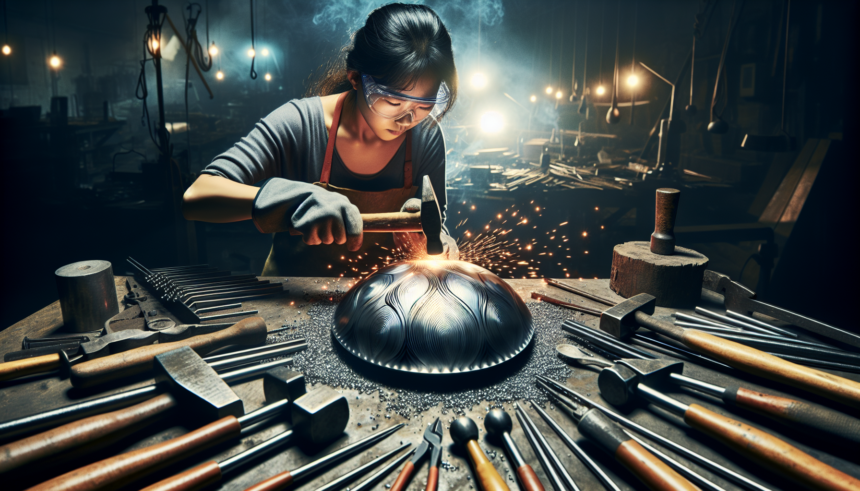The handpan is a mesmerizing and enigmatic instrument that captivates both musicians and listeners alike. Originating from the Hang drum developed by PANArt in Switzerland, the handpan has gained worldwide acclaim for its ethereal sound and artistic craftsmanship. At the heart of the handpan’s creation lies a meticulous, transformative journey from raw steel to a melodic masterpiece. This article delves into the handpan hammering process, illuminating the steps and intricate details involved in bringing this musical wonder to life.
1. Initial Material Selection
The creation of a handpan begins with the selection of high-quality steel sheets, which serve as the foundational material for the instrument. These sheets are typically made from nitrided steel, a material that ensures durability, resilience, and superior sound quality. Nitriding is a heat treatment process that hardens the steel’s surface, creating a robust and corrosion-resistant layer, ideal for the handpan’s needs.
2. Shaping the Steel
Once high-quality steel sheets are selected, the next step involves shaping these sheets into hemispheres. This shaping process can be achieved through various methods such as hydraulic pressing or manual hammering. Hydraulic pressing involves using mechanical force to form the steel into a dome-like shape, whereas manual hammering requires skilled artisans to meticulously hammer the steel into the desired curvature. This stage is crucial as it lays the groundwork for the handpan’s structure and sound characteristics.
3. Heat Treatment
Following the shaping process, the steel hemispheres undergo heat treatment to further enhance their acoustic properties. Heat treatment involves heating the steel to specific temperatures and then rapidly cooling it, strengthening the material and optimizing its resonant qualities. This step is vital to ensure that the handpan produces clear, harmonious tones when played.
4. Helmholtz Resonance Tuning
A critical and delicate phase in the handpan hammering process is the tuning of Helmholtz resonance. This involves creating precisely shaped and positioned dents or dimples on the surface of the hemispheres and adjusting their depths to achieve specific pitches. Skilled artisans carefully hammer and shape these areas by hand, using their expertise to bring out the desired notes. The Helmholtz resonance tuning process must be executed with precision, as it directly influences the handpan’s ability to produce melodic and harmonious sounds.
5. Sound Refinement
After the Helmholtz resonance tuning, the handpan undergoes further sound refinement. This involves fine-tuning the instrument to ensure each note is perfectly balanced and harmonized. Artisans use various tools and techniques to adjust the tension, curvature, and depth of the steel surfaces, bringing out the unique sounds and timbres that define a high-quality handpan.
6. Surface Treatment
The final stage in the handpan hammering process is surface treatment, which involves polishing and finishing the steel to enhance its aesthetic appeal and protect it from environmental elements. Artisans meticulously polish and coat the handpan with protective layers to ensure its longevity and maintain its visual allure. The result is a beautifully crafted instrument that not only sounds enchanting but also looks stunning.
Conclusion
The journey from raw steel to melodic masterpiece in the creation of a handpan is a testament to the dedication, skill, and artistry of the craftspeople involved. Each stage of the hammering process, from material selection and shaping to heat treatment, resonance tuning, sound refinement, and surface treatment, contributes to the instrument’s unique sound and visual beauty. As musicians and listeners, we are privileged to experience the fruition of this intricate process, captivating our senses and bringing harmony into our lives.
FAQs
1. What materials are commonly used to make handpans?
Handpans are typically made from nitrided steel sheets, a material that ensures durability, resilience, and superior sound quality. Nitrided steel undergoes a heat treatment process that hardens the surface, making it robust and corrosion-resistant.
2. How are handpans tuned?
Handpans are tuned through a process called Helmholtz resonance tuning. Skilled artisans create and adjust dents or dimples on the surface of the steel hemispheres to achieve specific pitches. This intricate process requires precision and expertise to ensure the handpan produces harmonious and melodic sounds.
3. Can a handpan be tuned after it has been made?
While minor adjustments can be made to a handpan after its initial tuning, significant changes to its tuning are challenging. The handpan is carefully crafted and tuned during its creation, and altering its tuning afterward may affect its structural integrity and sound quality.
4. How long does it take to make a handpan?
The creation of a handpan is a labor-intensive process that can take several weeks to months. Each stage, from material selection and shaping to heat treatment, resonance tuning, sound refinement, and surface treatment, requires meticulous attention to detail and expertise.
5. What makes handpans expensive?
Handpans are expensive due to the high level of craftsmanship, time, and expertise required to create them. The intricate hammering and tuning processes, combined with the cost of high-quality materials, contribute to their price. Additionally, handpans are often handcrafted by skilled artisans, making each instrument unique and valuable.





